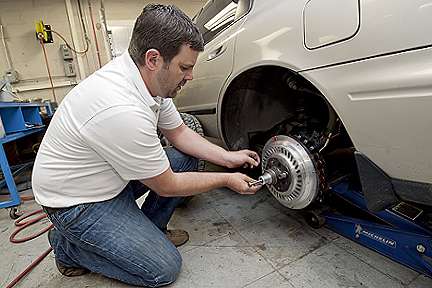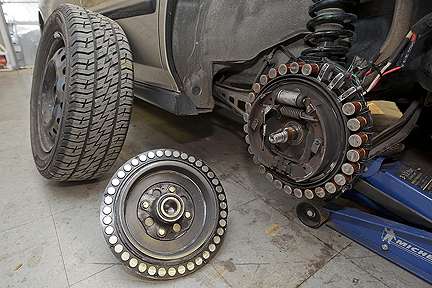July 24, 2012 report
Wheel hub motor concept drives hybrid progress at MTSU

(Phys.org) -- When news broke in 2009 that a former IBM engineer had devised a kit that turns any car into a plug-in hybrid for between $3,000 and $5,000, those interested in going-green technologies took notice and hoped it was more than just a concept. This month, Dr. Charles Perry and his team at Middle Tennessee State University, where he is now a professor, have something to show for the work that has been under way since 2008. Earlier this week, a school news release announced that Perry and team saw gas mileage increase anywhere from 50 to 100 percent on a 1994 Honda station wagon retrofitted with their laboratory prototype plug-in hybrid capability. This is a wheel-hub motor, plug in hybrid kit.
The key element in this gas-saving kit are electric motors in each rear wheel and a large lithium-ion battery, which is also mounted in the rear of the vehicle. The very point of the exercise, said Perry, now a professor in the engineering technology department of the school, has been to demonstrate the feasibility of adding an electrical motor to the rear wheel of the car without changing brakes, bearings, suspension —“anything mechanical.”
A member of his team sees the wheel-hub motor as an innovative technology that one can take and bolt on a car. “When people see that, their eyes light up. They think it might cost a lot of money and are surprised when you tell them it might be $3,000.”
The student team helping Perry have a range of capabilities that have supported the project, including specialties in mechanical design, electrical design, programming, computer numerical-control machining and finite-elements analysis modeling.
As lithium-battery technology improves, Perry said, the battery size can be reduced in production models. As a former IBM engineer he is no stranger to the challenges in bringing something out of a research lab and into a showroom, Perry is talking with several potential investors. He wants to use the funding to build and demonstrate a manufacturing version of this plug-in hybrid technology.

He and the team have reached the proof of concept stage to prove feasibility, he said, and with enough funding they can deliver proof of product. Investors, he noted, will want to see proven field-tested performance and reliability.
Perry said a manufacturing partner has stepped forward and will accompany him to anticipated upcoming presentations.
This would certainly not be the first or last attempt to work up a suitable retrofit kit as interest grows in hybrids. In 2008, the UK-based Motor Industry Research Association, an automotive design, development and certification consultancy, unveiled a plug-in hybrid retrofit system. The kit, they said at the time, had the potential to reduce fuel consumption and tailpipe emissions by 39 percent, and they applied it in a demo vehicle with removable lithium-ion phosphate battery pack. They built the demo with funding from the Energy Saving Trust’s Low Carbon R&D program.
More information:
Press release
© 2012 Phys.org


















